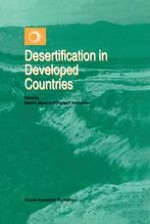1995 | OriginalPaper | Chapter
South Africa’s Arid and Semiarid Rangelands: Why Are They Changing and Can They Be Restored?
Authors : Suzanne J. Milton, W. Richard J. Dean
Published in: Desertification in Developed Countries
Publisher: Springer Netherlands
Included in: Professional Book Archive
Activate our intelligent search to find suitable subject content or patents.
Select sections of text to find matching patents with Artificial Intelligence. powered by
Select sections of text to find additional relevant content using AI-assisted search. powered by
Since the mid-19th century settled livestock ranching has been the major form of land use in South Africa, occupying 68% of the land surface. Decreases in livestock densities and ranch numbers during the past century imply that carrying capacities for domestic herbivores are falling. Differences in carbon isotope signals with soil depth and abrupt shifts in dominant plant species across ranch boundaries reveal that southern African rangelands are changing. Case studies suggest ways to control altered grassland composition, bush encroachment in arid savanna, and dominance by toxic and halophytic shrubs in arid shrublands. But climatic and biological factors constrain rates of passive recovery, and guidelines for active restoration are poor and techniques costly. Moreover, conservation of remaining good rangeland is seldom enforced, and economic considerations usually outweigh the land user’s desire to sustain diversity and productivity.
